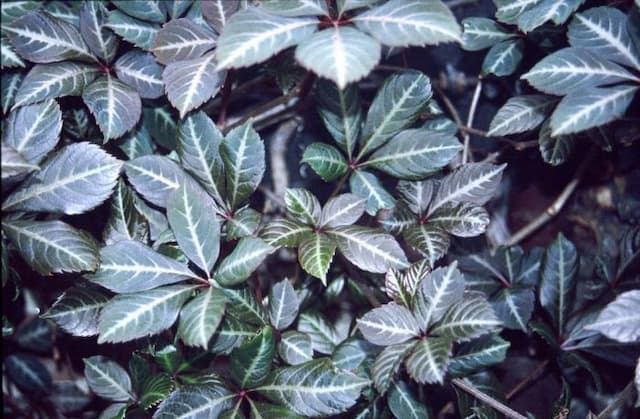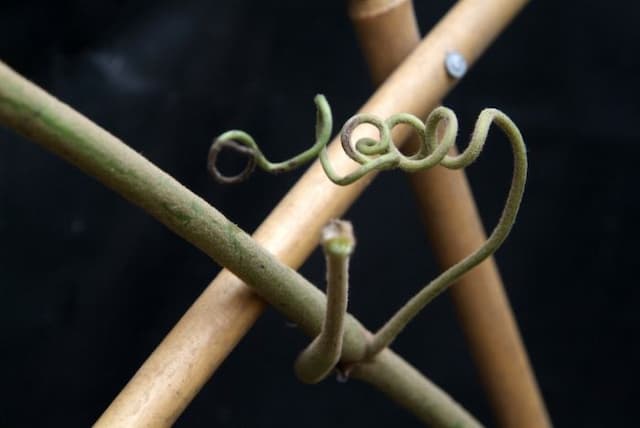Chasselas Vitis vinifera 'Chasselas' (G/o/w)

ABOUT
The plant known as Chasselas, a cultivar of grapevine, is characterized by its lush, green foliage and the clusters of fruit it produces. The leaves are broad with multiple lobes, often displaying jagged edges, creating a palm-like appearance. They have a rich green hue, which can transform into a variety of different colors, depending on the season. The fruit that Chasselas bears are grapes, which grow in clusters that hang down from the vines. These grapes typically have a thin skin and are quite juicy inside. They are generally a golden color when ripe, though some may also have a greenish tint. The vines themselves are woody and can be trained to grow along supports or trellises. The overall appearance of the Chasselas plant is one of an abundant and fruitful vine, full of vibrant leaves and attractive grapes that are often used for eating fresh or for making into wines.
About this plant
 Names
NamesSynonyms
Chasselas, Gutedel, Perlan, Chasselas Blanc, Chasselas Doré, Chasselas Golden, Fendant, Weißer Gutedel
Common names
Vitis vinifera 'Chasselas' does not have any synonyms, its basic scientific name is Vitis vinifera 'Chasselas'.
 Toxicity
ToxicityTo humans
The common name for Vitis vinifera 'Chasselas' is grapevine, specifically Chasselas grapes. Grapes are not toxic to humans and are widely consumed in various forms, such as fresh fruit, juice, and wine. However, individuals with certain conditions, such as grape allergies or sensitivities, should avoid consuming grapes to prevent allergic reactions or digestive issues.
To pets
Grapevine, particularly the Chasselas variety, is toxic to pets, including dogs and cats. Ingesting grapes can cause acute kidney failure in these animals. Symptoms of grape poisoning in pets may include vomiting, diarrhea, lethargy, abdominal pain, decreased appetite, and signs of kidney failure, such as decreased urination or anuria. If a pet ingests grapes, it is important to seek veterinary care immediately, as the condition can be life-threatening.
 Characteristics
CharacteristicsLife cycle
Perennials
Foliage type
Deciduous
Color of leaves
Green
Flower color
Green
Height
4-6 feet (1.2-1.8 meters)
Spread
6-8 feet (1.8-2.4 meters)
Plant type
Climber
Hardiness zones
7
Native area
Europe
Benefits
 General Benefits
General Benefits- Nutritional Value: The fruit of Vitis vinifera 'Chasselas' is rich in vitamins and minerals, particularly vitamin C and potassium.
- Culinary Use: Chasselas grapes are highly valued for fresh consumption and are also used in the production of white wine.
- Economic Importance: As a commercial crop, it contributes to the agricultural economy through the sale of grapes and wine production.
- Landscape Use: The plant can be used in landscaping for aesthetic purposes, such as creating vine-covered arbors or trellises.
- Pollinator Support: Grapevines can attract bees and other beneficial insects that pollinate various plants and crops.
- Cultural Significance: Grapes have a rich history and are an integral part of many cultures and traditions where they are used for festivals and rituals.
- Recreational Activities: Vineyards offer tourism and wine tasting opportunities, which supports local businesses and agricultural tourism.
 Medical Properties
Medical Properties- Antioxidant Activity: Chasselas grapes contain various antioxidants, such as flavonoids and resveratrol, which may protect cells from damage by free radicals.
- Cardiovascular Health: The resveratrol in Chasselas grapes has been associated with a reduced risk of heart disease by improving blood vessel function and reducing inflammation.
- Anti-inflammatory Properties: Various components in Chasselas grapes, like flavonoids, have potential anti-inflammatory effects which might aid in reducing chronic inflammation.
- Glycemic Control: Some studies suggest that compounds found in grapes like Chasselas can help in managing blood sugar levels, although more research is needed.
 Air-purifying Qualities
Air-purifying QualitiesThis plant is not specifically known for air purifying qualities.
 Other Uses
Other Uses- Chasselas vines can be trained over pergolas and arbors to provide shade during hot summers, with the added benefit of fruit.
- The leaves of the Chasselas grape plant can be used in culinary preparations, such as stuffing them with rice and meat to make dolmas.
- The flexible vine branches can be used for basketry or woven into wreaths and other decorative items.
- Chasselas grapes can be dried to make raisins, which can be used in baking or as a sweet snack.
- The juice from Chasselas grapes is sometimes used in the production of vinegar and grape seed oil.
- In some regions, the grapes are fermented into a light and fruity grape beer.
- The plant's tendrils can be used in floral arrangements for their unique coiled shape.
- Chasselas grape skins can be used as a natural dye for fabrics, yielding soft yellow or green hues depending on the processing.
- Young Chasselas shoots can be lightly cooked and eaten as a green vegetable in some culinary traditions.
- Grape must, the freshly crushed grape juice with skins, seeds, and stems, from Chasselas grapes is used in some countries to create a tangy syrup called 'pekmez' often used in desserts.
Interesting Facts
 Feng Shui
Feng ShuiThe grapevine is not used in Feng Shui practice.
 Zodiac Sign Compitability
Zodiac Sign CompitabilityThe grapevine is not used in astrology practice.
 Plant Symbolism
Plant Symbolism- Fertility - As a grapevine, Vitis vinifera 'Chasselas' is often symbolized with fertility due to its abundant fruit production and its ability to propagate easily.
- Abundance - The Chasselas grape is associated with abundance, being a resourceful plant that gives plenty of grapes used for eating as well as wine-making.
- Vitality - The vigorous growth of the grapevine stands for strong life force and vitality, mirroring the plant's robust nature.
- Transformation - This plant is emblematic of transformation, representing the change from grape to wine, a process of fermentation that is seen as alchemical.
- Celebration - Chasselas grapes are tied to celebration and joy, as grapes and wine are often present at festive occasions and have ceremonial importance.
 Water
WaterThe common grape vine should be watered deeply once or twice a week during the growing season, depending on the weather conditions, with about 1-2 inches of water. In the winter, reduce watering to every two to three weeks, ensuring that the soil around the vine does not completely dry out. Young vines may need more frequent watering to help establish deep roots, while mature vines with established root systems require less. During extreme heat or drought, supplemental watering may be necessary. It's important not to overwater as this can lead to root rot and other issues.
 Light
LightThe common grape vine thrives in full sunlight, needing at least 6 hours of direct sunlight each day to produce the best fruit. A spot that has clear exposure to the sun from morning to afternoon is ideal. Avoiding shaded areas will help ensure that the grape bunches receive even sunlight, which is essential for good sugar development and healthy growth.
 Temperature
TemperatureThe common grape vine prefers a temperate climate with ideal growing temperatures ranging from 75°F to 85°F. It can survive winter dormancy in temperatures as low as 20°F but should be protected from frost to prevent damage to the buds and fruit. Extended exposure to temperatures over 95°F can adversely affect fruit development, so providing some shade or cooling in extreme heat can be beneficial.
 Pruning
PruningPruning the common grape vine is essential to control its vigorous growth, improve sunlight exposure, and ensure a quality crop of grapes. Late winter, before the buds swell, is the best time for pruning. Mature vines should be pruned annually to remove dead or excess growth and to shape the vine. Proper pruning involves selecting a few strong canes from the previous year's growth and cutting back the rest.
 Cleaning
CleaningAs needed
 Soil
SoilThe best soil mix for Chasselas grape is well-draining, loamy soil with a pH between 6.0 and 7.0. Incorporate organic matter such as compost and a balanced, slow-release fertilizer to enhance soil structure and fertility.
 Repotting
RepottingChasselas grapes, being vigorous outdoor vines, are not typically repotted. Instead, they're planted in the ground where they can spread their roots widely.
 Humidity & Misting
Humidity & MistingChasselas grapes do not require specific humidity levels, but they thrive in outdoor environments with natural air circulation and should not be subjected to excessively humid conditions which can promote fungal diseases.
 Suitable locations
Suitable locationsIndoor
Not suitable for indoors; needs full sun and space to thrive.
Outdoor
Plant in full sun, provide trellis support, and ensure good airflow.
Hardiness zone
7-9 USDA
 Life cycle
Life cycleThe life cycle of Vitis vinifera, commonly known as the common grape vine, begins with seed germination, where warmth and moisture initiate the growth of a new vine. This is followed by the vegetative stage, in which the plant develops roots, shoots, and leaves in preparation for photosynthesis and growth. The vine then enters a flowering stage, during which it produces flower clusters that are pollinated and subsequently develop into grape bunches. After pollination, the fruit set stage involves the growth and maturation of grapes, which undergo veraison, the process where grapes change color and sugar content increases. Once fully matured, the grapes are harvested, which constitutes the reproductive stage of the vine’s life cycle. After harvest, the vine enters a period of dormancy, conserving energy for the next growing season.
 Propogation
PropogationPropogation time
Spring to Summer
The most popular method of propagating Vitis vinifera 'Chasselas', commonly known as the Common grapevine, is through hardwood cuttings. This process typically takes place in late winter to early spring, during the dormant period of the vine before active growth begins. To propagate by hardwood cuttings, one would select healthy, mature canes from the previous season's growth that are about pencil-thickness. These cuttings should ideally be 12 to 18 inches (30 to 45 centimeters) long and contain about 2 to 3 buds each. The cut end near the base of the vine is dipped in rooting hormone to facilitate root development and the cuttings are then planted in well-drained soil, with one bud buried and the rest above the soil surface. The soil should be kept moist until the cuttings have rooted and new growth appears, indicating successful propagation.









